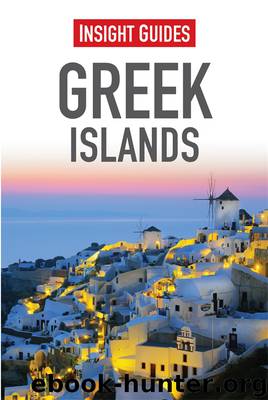Insight Guides: Greek Islands by Insight Guides

Author:Insight Guides
Language: eng
Format: epub
Tags: Travel, Greece, Greek Islands
Publisher: APA
Published: 2014-06-18T16:00:00+00:00
The Greeks understandably wanted to ignore the Italians‘three-decade presence, but now recognise that their architecture had ample merit.
Thirty-one years of Italian rule in the Dodecanese left a significant architectural heritage, which has only recently begun to be appreciated. Many structures were long neglected, apparently a deliberate policy by the Greeks, who would prefer to forget the entire Italian legacy, but since the late 1990s maintenance and repair work has been undertaken. In Lakkí, on Léros in the Northern Dodecanese, buildings along the grand boulevards and landscaped squares have undergone a thorough renovation in recent years .
These buildings are often erroneously dubbed “Art Deco”; while some, like Rhodes Aquarium and the stadium, certainly contain elements of that style, most are properly classed as Rationalist, or (on Léros) Streamline Modern. They grew out of various post-World War I European architectural, artistic and political trends, particularly Art Deco’s immediate predecessor, Novecento, which originated in a movement born in Milan in 1922. The collectivist ideologies of the time were also influential, as were the paintings of Giorgio di Chirico, the Greek-Italian painter born in Vólos in 1888.
From 1924 to 1936, Italy attempted to combine Rationalist architecture and local vernacular elements, both real and semi-mythical, into a supposed generic “Mediterranean-ness”. Every island got at least one specimen in this “protectorate” style, usually the police station, the post office, covered market or governor’s mansion, but only on the most populous or strategic Dodecanese islands like Rhodes, Kós, Kálymnos and Léros were plans drawn up for comprehensive urban reordering.
On Rhodes, this meant the creation of a Foro Italico (administrative centre) at Mandráki. The evolving imperatives of Fascism also required a square (in Rhodes, the Piazza dell’Imperio in the Foro Italico) for large-scale assemblies. There were also structures in neo-Crusader style, such as the Cathedral of St John (now Evangelismós).
The period 1936–41 was marked by intensified Fascist ideology and increased reference to the islands’ Latin heritage (the Romans and their purported successors, the Knights of St John). This entailed “purification”, stripping many public buildings in Rhodes (although not in Kós, where a 1933 earthquake devastated much of the town) of orientalist ornamentation, and replacing it with poros stone cladding to match medieval structures in the Old Town. Added to this was a monumental severity and rigid symmetry – as with the theatre in Rhodes – echoing institutional buildings (especially Fascist Party headquarters) in Italy. Many Old Town buildings from the Knights’ era were restored or, in the case of the Palace of the Grand Masters , entirely rebuilt.
Download
This site does not store any files on its server. We only index and link to content provided by other sites. Please contact the content providers to delete copyright contents if any and email us, we'll remove relevant links or contents immediately.
Spell It Out by David Crystal(35811)
Underground: A Human History of the Worlds Beneath Our Feet by Will Hunt(11810)
A Year in the Merde by Stephen Clarke(5050)
Venice by Jan Morris(2402)
Claridge's: The Cookbook by Nail Martyn & Erickson Meredith(2236)
My Paris Kitchen: Recipes and Stories by Lebovitz David(2109)
A TIME OF GIFTS by Patrick Leigh Fermor(2082)
The Plantagenets by Dan Jones(1912)
Welcome to the Goddamn Ice Cube by Blair Braverman(1865)
Bang Poland: How To Make Love With Polish Girls In Poland by Roosh V(1837)
Top 10 Prague (EYEWITNESS TOP 10 TRAVEL GUIDES) by DK(1817)
From Russia with Lunch by David Smiedt(1782)
The Isle of Mull by Terry Marsh(1782)
The Finnish Way by Katja Pantzar(1782)
A TIME TO KEEP SILENCE by Patrick Leigh Fermor(1745)
Rick Steves London 2018 by Rick Steves & Gene Openshaw(1726)
A Taste of Paris by David Downie(1724)
Merde in Europe by Stephen Clarke(1653)
Insight Guides Experience Tokyo by Insight Guides(1643)
